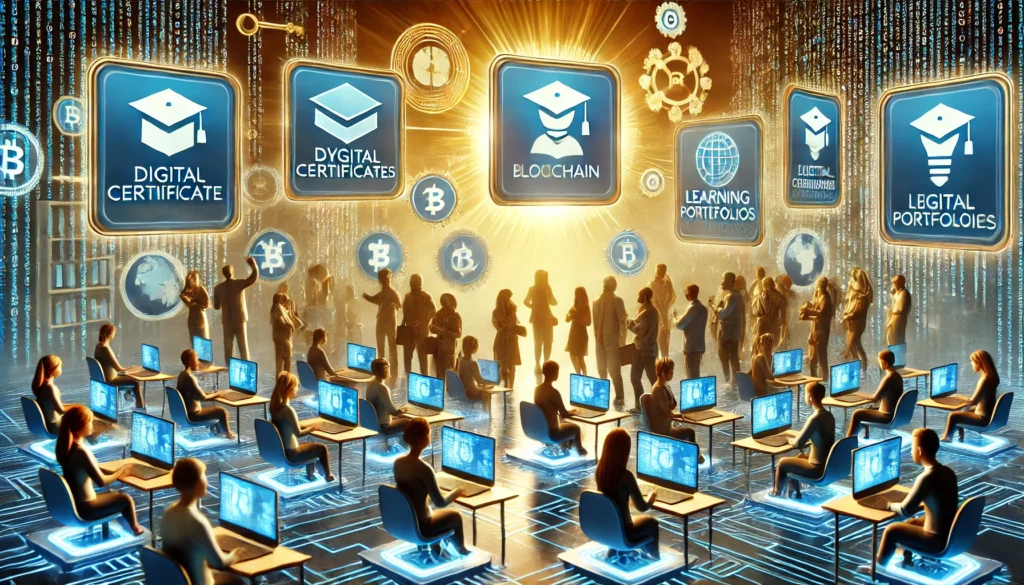Blockchain technology is revolutionizing the education sector by addressing critical challenges such as credential verification, accessibility, and transparency. By leveraging its decentralized and immutable nature, blockchain enables secure storage, verification, and sharing of academic credentials and learning records, fostering trust and efficiency. This article explores the applications, benefits, and challenges of blockchain in education and its role in shaping the future of lifelong learning.
The Role of Blockchain in Education
Blockchain serves as a decentralized ledger that securely records and stores data in an immutable format. In education, it is being applied to:
- Credential Verification: Providing tamper-proof academic records and certificates.
- Lifelong Learning Records: Creating a comprehensive, portable, and verifiable record of a learner’s achievements across multiple institutions and platforms.
- Decentralized Learning Platforms: Enabling direct interactions between learners, educators, and employers without intermediaries.
Applications of Blockchain in Education
- Credential Verification
- Traditional credential verification is time-consuming and prone to fraud. Blockchain streamlines the process by storing certificates and diplomas as immutable digital records.
- Example: Graduates can share a verifiable digital version of their degree with employers, eliminating the need for manual verification.
- Projects:
- MIT’s Digital Diplomas: The Massachusetts Institute of Technology issues blockchain-based diplomas to students, ensuring easy and secure verification.
- Blockcerts: An open standard for creating, issuing, and verifying blockchain-based certificates.
- Lifelong Learning Portfolios
- Blockchain enables learners to maintain a digital portfolio of their skills, certifications, and learning experiences throughout their lives.
- Learners can aggregate achievements from formal education, online courses, and work experiences into a single, portable record.
- Decentralized Education Marketplaces
- Blockchain powers decentralized platforms where educators and learners can interact directly. Educators can offer courses or certifications, and learners can pay using cryptocurrencies or tokens.
- Example: BitDegree offers blockchain-based certificates and incentivizes learners through tokenized rewards.
- Micro-Credentials and Skill Badges
- Institutions and platforms can issue micro-credentials or badges for completing specific skills or courses. These records, stored on the blockchain, provide a granular view of a learner’s competencies.
- Example: Platforms like Credly issue verifiable digital badges to acknowledge skills acquisition.
- Combatting Credential Fraud
- By storing educational credentials on a blockchain, institutions ensure their authenticity and prevent forgery. Employers and academic institutions can instantly verify the legitimacy of qualifications.
- Global Accessibility and Equity
- Blockchain allows learners from underprivileged or remote areas to securely access and share their credentials without relying on centralized institutions.
- Example: Refugees or displaced individuals can present their blockchain-based learning records to pursue further education or employment.
- Smart Contracts in Education
- Smart contracts automate administrative processes, such as issuing certifications, verifying attendance, and processing scholarships or funding.
- Example: Automatic release of course completion certificates upon meeting predefined criteria.
Benefits of Blockchain in Education
- Enhanced Trust and Transparency
- Blockchain provides a tamper-proof record of educational achievements, fostering trust among institutions, learners, and employers.
- Efficiency
- Automating credential verification and other administrative processes reduces time and costs for both learners and institutions.
- Portability and Ownership
- Learners gain control over their academic records, which can be accessed and shared globally without institutional barriers.
- Decentralization
- Decentralized platforms eliminate the need for intermediaries, enabling direct and secure interactions between stakeholders.
- Scalability
- Blockchain systems can scale to accommodate millions of learners and records, making them suitable for large educational systems and global applications.
Challenges of Implementing Blockchain in Education
- Technical Complexity
- Integrating blockchain systems into existing educational infrastructures requires significant technical expertise and resources.
- Data Privacy
- Balancing blockchain’s transparency with privacy regulations like GDPR is challenging, especially when dealing with sensitive personal information.
- Cost
- While blockchain reduces long-term costs, the initial investment in technology, infrastructure, and training can be high.
- Adoption Resistance
- Educational institutions may resist adopting blockchain due to a lack of awareness or fear of disrupting traditional systems.
- Interoperability
- Ensuring compatibility between different blockchain platforms and educational systems is crucial for widespread adoption.
Future Trends in Blockchain-Based Education
- Universal Learning Records
- Blockchain could standardize and unify learning records across institutions, making global credential portability a reality.
- Integration with Artificial Intelligence (AI)
- AI-powered systems can analyze blockchain-based learning records to personalize education and recommend relevant courses or skills.
- Tokenized Education Systems
- Institutions may adopt token economies, where learners earn tokens for completing courses or achieving milestones, which can be redeemed for further learning opportunities.
- Corporate Adoption
- Companies may use blockchain to verify employee qualifications and create internal learning systems for upskilling.
- Blockchain and the Metaverse
- In virtual learning environments within the metaverse, blockchain can ensure secure ownership of educational assets and certificates.
Case Studies and Real-World Examples
- Sony Global Education
- Sony uses blockchain to share and verify student achievement records securely, enabling global collaboration between institutions.
- Woolf University
- A blockchain-powered university that automates administrative processes and ensures the security of academic records.
- Odem.io
- A decentralized platform for education and employment where learners can access blockchain-verified credentials and connect with employers.
Conclusion
Blockchain technology is poised to revolutionize education by enhancing transparency, efficiency, and accessibility. By enabling secure and verifiable credentials, lifelong learning portfolios, and decentralized education systems, blockchain empowers learners, institutions, and employers alike. While challenges like cost and interoperability remain, ongoing innovation and adoption are driving the transformation of education in the digital age. As blockchain continues to evolve, its integration with education promises a more equitable, efficient, and learner-centric future.
